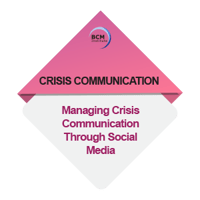 Social Media
Social Media
Despite the ever-changing environment of social media, the basic rules for Crisis Communication have not changed. The crisis should be handled quickly, accurately, professionally and with care. In addition to adding honesty, sincerity, and transparency, social media has taken the communication plan to a new level by speeding up the process.
It is important to start building the organisation’s social media efforts and not to wait until after a crisis has occurred. In a crisis management situation, there is little difference to this, it is just on a bigger scale.
Trends in Social Media Crisis Communication and Management
The trends in social media crisis communication and management are:
Everything happens at lightning speed
During the first 24 hours, the bad news spreads very much faster than ever via Twitter, Facebooks, and the collective life streams. Besides traditional media, there is also a requirement to monitor all consumer-generated media. When responding to emerging crisis, you may need to react fast in a matter of hours and not days. Have a streamlined social media approach and a team in place. It is exceptional useful to have the necessary experience in social media, and this will help you respond much faster.
People demand “hyper-transparencies”
There is no secret anymore, and there is a slim chance of hiding information. Any individual has the power to expose what were once “private” conversations, making it public and expect what you say to be blogged. The organisation should be ready to reconcile contradictory business practices. It is important to ensure that all the efforts put into responding to the public is sincere, defensible and authentic.
Dialog as important as message delivery
Be ready for two-way dialog as one way messaging does not work anymore in the world where people crave dialog. Inviting customers into a conversation is the most effective way to build goodwill and brand advocates who support you during a crisis. The use of press releases and scripted interactions does not satisfy communication solely anymore. An existing system in place for listening is critical to remaining responsive.
Search reputation delivers multimedia
The reputation of an organisation is built or broken in a search for the interest. Google provides “universal search”, making multimedia critical. It is also difficult to dislodge content once it is in the search results.
Brand detractors have the same tools
An individual voice can travel around the world more quickly today. Small organisation tends to be nimble and faster with social media. It is critical to listen to consumer generated media. Everyone is an influencer in his or her circle, so traffic alone cannot be the only metric for judging influence.
Social Media as a Crisis Communication and Management Tool
The typical crisis management sees many people complaining, debating, and discussing your brand online. Many of these discussions may be factually inaccurate, and many will be from customers who have had bad experiences. These are the kinds of discussions that should be responded to, in the right manner.
Every crisis is different, and there is no simple set of rules about how to use social media in these situations. Some of the observations arise from looking at how people have successfully (or poorly) managed crises in the past:
Keep people up-to-date with the use of social media
"Not knowing" is the worst thing in a crisis. Hence, social media can be useful as a tool to keep people informed. Update regularly as things unfold and make sure you are updating with actual developments. The benefit of having a well-established online community or blog is that you can then use it for this purpose. Make it the place people can go to for information, keep it honest and keep it current.
Make sure the people representing your brand know what they are talking about
When you are unhappy, there is nothing worse than feeling that the person talking to you does not understand or know what is going on. Ensure that the people engaging on behalf of your brand in social media are always up-to-date on what is going on and able to articulate openly and truthfully for the brand. They need to be immersed in the brand and internal process and be able to update people promptly and escalate any issues effectively within your organisation. This does not mean they need to work for you directly, but it mean they need to be fully immersed in your brand, and they should be experienced and effective brand communicators.
Engage people talking about you - be it compliments or complaints
When a crisis happens, people are going to complain, and these claims need to be address. The ideal way is to do so in an informative and direct manner. Correct errors and provide information to the people who are complaining. Start by helping them to resolve their problems and disappointments so as to stop them from talking about you in social media. For example, it can be by telling them where to get back the refunds that they deserved or link them to your blog where you are keeping people up-to-date.
Know Your Tools?
You need to know your communication and resources channels in order to apply your crisis communications strategy. There is a need to analyse the current tools and platforms such as email marketing, press releases, blog of websites, statement and store on sites. The key is to analyse how and when to use them.
Work effectively with the hub and the spokes of your social media presence
You cannot expect to engage everybody in detail on Twitter, in Facebook or on forums, online communities, and blogs. You will end up repeating the same information many times, and this information will usually become out of date quickly. This is where having a well-developed hub-and-spoke model of social media engagement comes into its own. For example, if you have an online community, and developed hub where you can send people to get real-time and up-to-date updates on what is happening, you can engage them where they are (Twitter, Facebook, forums, etc.) by directing them here.
Are you relationship ready?
Social media is the world where everyone is equal, and no one owns the communication channels. There is a need to create “brand friends” who knows you, trust you and defend you when it is necessary. These brand friends know your brand’s value and its human side because you have built a relationship beforehand.
Do not wait for crisis to hit to build engagement
When a crisis hits, it will be the easiest if you already have a clear process put in place for dealing with discussions and complaints about your brand online. You need a blog or online community that people recognise as the place to go to talk about your brand. Moreover, you need a well-established presence in social media. Without this, you will find it much more challenging to go in and take part in discussions when things go wrong. You will be the outsider and newbie when you ought to be the centre of the conversation. To prevent this, you need to have a history of engaging your customers; not just running social media marketing campaigns.
Overall, when a crisis hits, social media can be a useful and powerful tool only if you have been using it to engage people for a long-term. You have experiences in dealing with criticisms online, and you know which area people are likely to complain. Make it simple for people to contact you and to find information from you. You do not want to land yourself in a situation where you will need to deal with hundreds or thousands of individual complaints scattered around the social media web. You want people to know where to get relevant information and where to complain and seek for assistance. Moreover, you want this to be a place you manage and facilitate. You want people to come to you, so you can deal with their problems and update them on what's going on. You want a place to send people to if they are talking about you online.
Social media is a powerful crisis management tool, provided if you have been managing it when you are not in a crisis mode too. It is real engagement, not campaign-based marketing. In a crisis, it will be easy to see which is which.
 Reference
Reference
Goh, M. H. (2015). A Manager's Guide to Implementing Your IT Crisis Communication Plan. Business Continuity Management Specialist Series. Singapore: GMH Pte Ltd.
Extracted from "Managing Crisis Communication through Social Media"
More Information About Crisis Communication Blended Learning
To know more about our blended learning program and when the next course is scheduled, feel free to contact our friendly course consultant colleagues via sales.ap@bcm-institute.org. They are the BL-CC-3 Blended Learning CC-300 Crisis Communication Implementer and the BL-CC-5 Blended Learning CC-5000 Crisis Communication Expert Implementer.
 |
 |
|
 |
 |
 |
Please feel free to send us a note if you have any of these questions to sales.ap@bcm-institute.org |


![[BL-CC-3] CC-300 Blended Learning Tell Me More](https://blog.bcm-institute.org/hs-fs/hub/3893111/hub_generated/resized/81e562e5-9ec3-4eec-a4ff-3f983c637a87.png?width=250&height=64&name=81e562e5-9ec3-4eec-a4ff-3f983c637a87.png)



